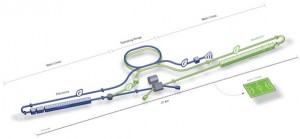
Schematic image of the ILC accelerator. For the staged approach, the main linac could be shorter than the planned length in the {em}Technical Design Report.{/em}
On 18 October, a meeting of Japanese high-energy physicists to discuss a “phased execution” of the International Linear Collider was held at KEK laboratory, Tsukuba, Japan.
This meeting was hosted by JAHEP, the Japan association of high-energy physicists, and was called an “expanded” meeting. JAHEP usually hold regular meetings with 15 committee members who were elected by the Japanese HEP community. “We hold expanded version of the meeting to promote open and wide discussion by community members on important issues,” said Sachio Komamiya, Chair of the JAHEP. “We recognised the ILC as an urgent priority of the community, and decided to hold the extended meeting.”
Why does the Japanese HEP community see ILC as an urgent priority?
JAHEP accepted the March 2012 recommendations of the Subcommittee on Future Projects of High Energy Physics and adopted them as JAHEP’s basic strategy for future projects. Then in July 2012 a new particle consistent with the Higgs boson was discovered at CERN’s Large Hadron Collider, and in December 2012 the Technical Design Report (TDR) and Detailed Baseline Design (DBD) report of the ILC will be completed by the worldwide collaboration.
In addition to those developments, a national budget were allocated for geological investigations for two Japanese candidate sites, Kitakami in Iwate prefecture, and Sefuri located between Saga and Fukuoka prefectures. “Also we see the rise of worldwide community’s expectation towards Japan,” says Komamiya.
The so-called phased execution (or staged approach) is the plan to build a shorter ILC accelerator than the one designed in the ILC TDR, in the beginning of the project as a Higgs factory.
The baseline design foresees an ILC that is about 31 kilometres long and provides a centre-of-mass energy of 500 GeV. The phased execution plan targets a lower energy of 250 GeV as a first phase, because of the mass of Higgs-like particle discovered by LHC in July – 126 GeV. “New physics starts at 126 GeV. So, a 250-GeV machine, which can produce tons of those particles with 126 GeV mass, will bring us a great possibility to find a law of new physics at a stretch,” said Satoru Yamashita of University of Tokyo, who gave a talk on ILC physics case at the meeting. “We can take best advantage of the linear accelerator. The circular machines have a limitation on the extension of the length of the accelerator tunnel, but a linear collider has flexibility. We can extend the machine as experiment goes.”
Following Yamashita, Akira Yamamoto, one of the project managers of the GDE, explained the R&D status of the ILC accelerator. He summarised the R&D activities, and wrapped up his talk by saying “the ILC can be built, based on the TDR technology.” However, the TDR deals with the baseline machine of a 500-GeV accelerator, and the theme of the discussion of the meeting, phased execution, won’t be described as a main goal, but briefly discussed in the chapter on the possible upgrade and staging options.
After two hours of discussion, the attendees agreed to publish a “Proposal for a Phased Execution of the International Linear Collider Project” in the following scenario:
(1) Physics studies shall start with precision study of the “Higgs Boson” and will evolve into studies on top quark, “dark matter” particles, and Higgs self-couplings, by upgrading the accelerator. A more specific scenario is as follows:
(A) A Higgs factory with a centre-of-mass energy of approximately 250 GeV shall be constructed as a first phase.
(B) The machine shall be upgraded in stages up to a center-of-mass energy of ~500 GeV, which is the baseline energy of the overall project.
(C) Technical extendability to a 1 TeV region shall be secured.
(2) A guideline for shares of the construction costs is that Japan covers 50% of the expenses (construction) of the overall project of a 500-GeV machine. The actual shares, however, should be left to negotiation among the governments.
Some meeting attendees expressed their concern about the ILC to be realised in Japan: the ILC might be the only high-energy physics project in Japan, since the ILC is a huge project that might eat up all of the budget. To respond the concern, Atsuto Suzuki, Director General of KEK, said, “as scientists, we all need to think of the way to realise something. If you always think based on your limited knowledge, experience, or prejudice, you cannot make things happen, especially something big like the ILC. It’s no use to make a judgment based only on the data you have now. You need to be foolish sometimes.”
The full text of the recommendation is available at the JAHEP website.

Recent Comments